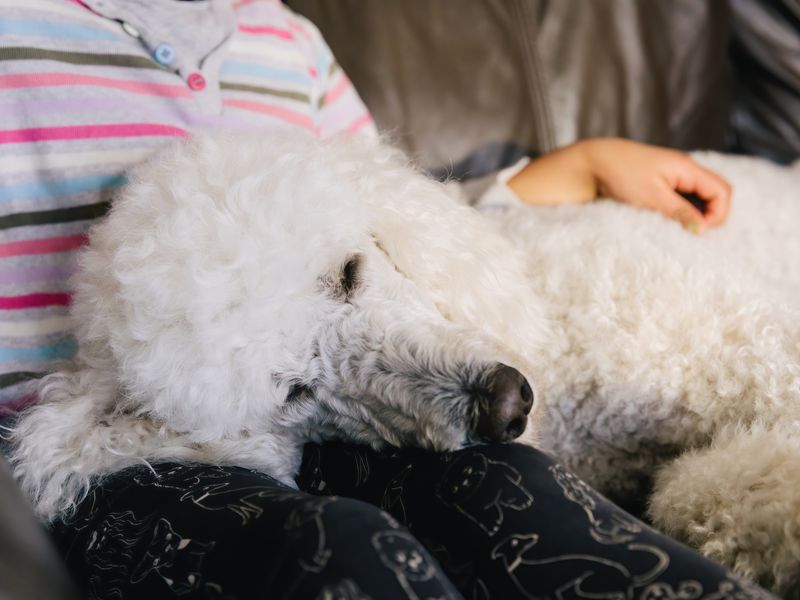Everything you need to know if your dog is in heat
Top tips for helping your dog through their heat season.

Your pooch being in heat can be a difficult thing to navigate, particularly if you’re going through it for the first time.
Our expert guidance will help you understand more about dog heat, what to look out for, and how to help your dog through it.
What does it mean for a dog to be in heat?
Being in heat, or ‘in season’, refers to the fertile period of a female dog’s reproductive cycle – when they can become pregnant. A dog’s heat period is usually accompanied by changes in behaviour.
When do dogs go into heat?
Most female dogs will have their first heat at around 6 months old, but timings can vary depending on the dog. Smaller pooches often have their first heat season earlier than large dogs.
Some dogs experience their first heat season as late as 2 ½ years old. Once they’ve begun, their heat seasons should occur every six to seven months - roughly twice a year.
Gaps between cycles generally become longer as dogs get older, but they can still become pregnant.
Signs your dog is in heat
If your dog is in season there will likely be some physical changes, behavioural changes, or a combination of the two.
Physical signs of heat include:
- their vulva becoming red and swollen
- bleeding from the vulva – usually a red, watery red, or yellowy brown discharge
- peeing more than usual.
Behavioural signs include:
- a change in social behaviour
- licking their back end more than usual
- unusual resting behaviour – for example, a change in bed or sleeping habits
- your dog seems to be roaming further than usual
- a change in cleaning and grooming behaviours
- humping.
These are just some of the signs your dog might be in heat. You may notice only one or a few of these. Speak to your vet if you’re concerned or for more guidance.
How long will my dog be in heat for?
Each heat cycle usually lasts for 2 to 4 weeks. During this time, your dog will likely bleed for around 7 to 10 days. Some dogs bleed heavily, while others bleed very little.
Some pups will have longer cycles, and some shorter, but they should be regular. Speak to your vet if you think your dog’s seasons are irregular.
Can I have my dog spayed while she’s in heat?
Vets avoid spaying female dogs when they're in heat due to a higher risk of bleeding during surgery. So, it’s usually best to spay your dog in between heat cycles – at least 3 months after being in heat, or before her first heat if appropriate.
This, however, should always be discussed with your vet, who’ll assess your dog and their individual needs.
How to stop a dog bleeding in heat
You can’t, so don’t try to. We recommend having your dog neutered at a time that’s right for them, as it prevents bleeding.
How to care for and comfort your dog when she’s in heat
As an owner, seeing your beloved pooch go through heat can be worrying, and it’s likely the same for them. Your dog may find what’s going on with their body confusing, and it may bring them some anxiety.
It’s important to help them feel safe and comfortable through it.
Some ways of caring for your dog during their heat cycle:
- allow them as much rest as they need
- comfort them if they seek comfort
- keep them on the lead and away from unneutered male dogs. This will prevent any unwanted pregnancies
- stick to their routine. A change of routine, e.g. locking them in the kitchen so they don’t bleed on the carpet, can cause distress
- if you are restricting certain areas of the house, introduce this in advance so it’s not new to your pup
- monitor their behaviour, this will help you prepare for future heat cycles.
These are just some of the ways to keep your best pal feeling safe and comfortable through their heat. Speak to your vet for more guidance, or if you’re concerned about anything.
How to know when dog heat is over
Each heat typically lasts two to four weeks, but it can be difficult to know exactly when it’s over for your dog.
We recommend keeping your pup on their lead at least a week after bleeding stops. Your dog will still be fertile for a period after bleeding has stopped, but the exact time is hard to judge.
Top tip: If you notice male dogs still showing a keen interest in your dog, keep them on the lead a while longer. This will avoid any unwanted pregnancies.
As heat timelines can be difficult to pin down, neutering your dog is a great way to prevent them becoming pregnant. Speak to your vet for more advice or if you’ve any concerns.



